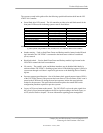
Technical Reference Guide
Compaq Evo and Workstation Personal Computers
Featuring the Intel Pentium 4 Processor
Second Edition - January 2003
4-33
The systems covered in this guide utilize the following specialized functions built into the LPC
47B367 I/O Controller:
♦ Power/Hard drive LED control – The I/O controller provides color and blink control for the
front panel LEDs used for indicating system events as listed below:
System Status Power LED HD LED
S0: System on (normal operation) Steady green Green w/HD activity
S1: Suspend Blinks green @ 1 Hz Off
S3: Suspend to RAM Blinks green @ 1 Hz Off
S4: Suspend to disk Blinks green @ 0.5 Hz Off
S5: Soft off Off - clear Off
Processor not seated Steady red Off
CPU thermal shutdown Off (system powers down) Off (system powers down)
ROM error Blinks red @ 1 Hz Off
Power supply crowbar activated Blinks red @ 0.5 Hz Off
System off Off Off
NOTE:
[1] Later systems using PCA#s 011305, 011308, or 011311 will power down for this condition.
♦ Intruder sensing – Used on Small Form Factor and Desktop models, battery-backed D-latch
logic internal to the LPC47B367 is connected to the hood sensor switch to record hood
(cover) removal.
♦ Hood lock/unlock – Used on Small Form Factor and Desktop models, logic internal to the
LPC47B34x controls the lock bar mechanism.
♦ I/O security – The parallel, serial, and diskette interfaces may be disabled individually by
software and the LPC47B367’s disabling register locked. If the disabling register is locked, a
system reset through a cold boot is required to gain access to the disabling (Device Disable)
register.
♦ Processor present/speed detection – One of the battery-back general-purpose inputs (GPI26)
of the LPC47B367 detects if the processor has been removed. The occurrence of this event is
passed to the ICH2 that will, during the next boot sequence, initiate the speed selection
routine for the processor. The speed selection function replaces the manual DIP switch
configuration procedure required on previous systems.
♦ Legacy/ACPI power button mode control – The LPC47B367 receives the pulse signal from
the system’s power button and produces the PS On signal according to the mode (legacy or
ACPI) selected. Refer to chapter 7 for more information regarding power management.


















